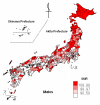Geographical distribution for malignant neoplasm of the pancreas in relation to selected climatic factors in Japan
- PMID: 17651508
- PMCID: PMC1971256
- DOI: 10.1186/1476-072X-6-34
Geographical distribution for malignant neoplasm of the pancreas in relation to selected climatic factors in Japan
Abstract
Background: Malignant neoplasm of the pancreas has become one of the leading causes of death from malignant neoplasm in Japan (the 5th in 2003). Although smoking is believed to be a risk factor, other risk factors remain unclear. Mortality from malignant neoplasm of the pancreas tends to be higher in northern Japan and in northern European countries. A recent study reported that standardized mortality ratios (SMRs) for malignant neoplasm of the pancreas were negatively correlated to global solar radiation level. People residing in regions with lower solar radiation and lower temperatures may be at higher risk of development of malignant neoplasm of the pancreas. Therefore, this study aimed to examine the relationship between SMRs for malignant neoplasm of the pancreas and climatic factors, such as the amount of global solar radiation and the daily maximum temperature in Japan.
Results: The study used multiple linear regression models. Number of deaths and demographic data from 1998 to 2002 were used for the calculation of SMR. We employed mesh climatic data for Japan published in 2006 by the Japan Meteorological Agency. Regression coefficients for the amount of global solar radiation and the daily maximum temperature in males were -4.35 (p = 0.00034) and -2.81 (p < 0.0001) respectively, and those in females were -5.02 (p < 0.0001) and -1.87 (p < 0.0001) respectively. Increased amount of global solar radiation or daily maximum temperature was significantly related to the decreased SMRs for malignant neoplasm of the pancreas in both males and females.
Conclusion: This study suggested that low solar radiation and low temperature might relate to the increasing risk of malignant neoplasm of the pancreas. Use of group data has a limitation in the case of evaluating environmental factors affecting health, since the impact of climatic factors on the human body varies according to individual lifestyles and occupations. Use of geographical mesh climatic data, however, proved useful as an index of risk or beneficial factors in a small study area. Further research using individual data is necessary to elucidate the relationship between climatic factors and the development of malignant neoplasm of the pancreas.
Figures




References
-
- Lin Y, Tamakoshi A, Wakai K, Kawamura T, Aoki R, Kojima M, Ohno Y. Descriptive epidemiology of pancreatic cancer in Japan. J Epidemiol. 1998;8:52–59. - PubMed
-
- Michaud DS. Epidemiology of pancreatic cancer. Minerva Chir. 2004;54:99–111. - PubMed
-
- Ghadirian P, Thouez JP, PetitClerc C. International comparisons of nutrition and mortality from pancreatic cancer. Cancer Detect Prev. 1991;15:357–362. - PubMed
MeSH terms
LinkOut - more resources
Full Text Sources
Medical

